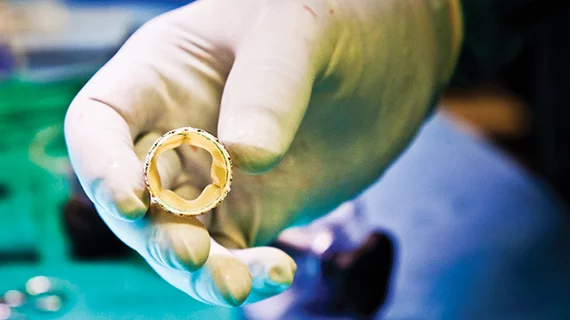Despite being performed in an older population with more cardiovascular comorbidities, transcatheter aortic valve replacement (TAVR) demonstrated similarly low rates of postoperative stroke and mortality compared with surgical aortic valve replacement (SAVR) in a study of patients with previous strokes.
TAVR has increasingly been an alternative to SAVR for patients deemed at high or prohibitive surgical risk and is starting to be investigated in intermediate-risk populations. However, stroke has long been one of the “most feared procedural complications” of TAVR, according to the authors of a research letter published May 21 in the Journal of the American College of Cardiology. However, previous landmark studies of TAVR excluded patients who had experienced stroke within six months before the procedure.
Four researchers led by Rupak Desai, MBBS, addressed this gap by studying 2,695 patients undergoing SAVR and 839 undergoing TAVR using the National Inpatient Sample (NIS). All the patients had a previous history of stroke, and it didn’t matter how recently the event had occurred.
The TAVR group was 11 years older on average (82 versus 71), more often female and had a higher burden of cardiovascular morbidities and pacemaker implants (10.7 percent versus 5.9 percent). Despite these differences, TAVR and SAVR were associated with similar rates of in-hospital mortality (2.4 percent for TAVR, 2.8 percent for SAVR) and postoperative stroke (1.4 percent versus 1.2 percent).
In addition, the mean length of stay was seven days for TAVR and 10 days for SAVR, and procedural myocardial infarction was also lower (1.3 percent versus 2.5 percent).
“Although we had a TAVR group consisting of older age population and higher cardiovascular comorbidities, there was no statistically significant difference in the all-cause in-hospital mortality and post-operative stroke incidence as compared with the SAVR group, and the TAVR group also demonstrated a favorably lower rate of post-procedure cardiovascular complications, which is consistent with previous trial results,” Desai and coauthors wrote. “Therefore, the prior history of stroke should not be considered a strict contraindication to carry out TAVR among the patients not eligible for SAVR.”
The researchers noted the NIS database doesn’t have information on the time from stroke to aortic valve replacement, so it wasn’t possible to analyze the results based on specific time frames.

